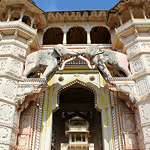
 Bundi. The very name is evocative. Translated literally it means sweetened, fried chickpea flour—a snack indigenous to Rajasthan. When applied to a small, sleepy, powder-blue painted town nestled in a deep gorge surrounded on three sides by the Aravalli hills with a spectacular fort and palace looming over it, it becomes synonymous with one of India’s best kept secrets. A secret with myriad secrets within its folds.
Bundi. The very name is evocative. Translated literally it means sweetened, fried chickpea flour—a snack indigenous to Rajasthan. When applied to a small, sleepy, powder-blue painted town nestled in a deep gorge surrounded on three sides by the Aravalli hills with a spectacular fort and palace looming over it, it becomes synonymous with one of India’s best kept secrets. A secret with myriad secrets within its folds.
Founded by a gentleman of the Meena tribe who went by the name Bunda, it was annexed by Rao Deva Hada in 1342, founder of Bundi [the princely state] and Hadoti [land of the great Hada Rajputs]. Friends with the Mughals and thereafter, the British Raj, it retained its princely status till 1947. Not many venture into Bundi; neither today nor in the past.
Here are five secrets I discovered in Bundi which make it the treasure trove that it is. If you know of more, please do share in the comments section. 😊 Continue reading




